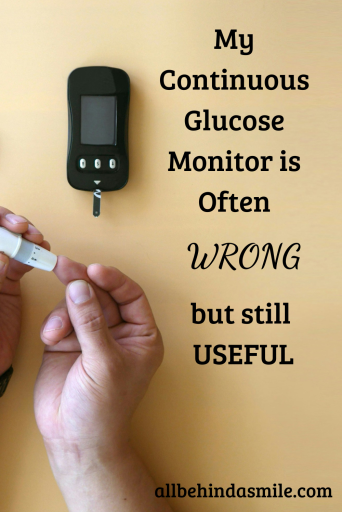A bit over a month ago, my doctor (suspecting diabetes) prescribed me a continuous glucose monitor. The monitor and I have already had our ups and and downs… and although the one I chose (the Dexcom G7) says it needs no calibration, the false low alarms that typically keep me up most of the night each time I put on a new sensor tell me otherwise.

It took me an embarrassingly long time, but after realizing the numbers (often in the 40s) on the low alarm didn’t match how I felt, I started doing a finger stick to compare.
Now, each time I put on a new sensor, I calibrate it as often as the sensor allows (about once every hour or so) to get the most accurate readings as soon as possible. Also, I don’t put the sensor on late in the day… because that almost guarantees an interrupted night (with false low alarms).
Is the Expense Worth It?
The continuous glucose monitor I chose is NOT cheap, especially since I don’t have traditional health insurance. Thankfully, the manufacturer often offers a discount, or I wouldn’t be using this product.
That aside, I understand with the expense of this product, it’s a luxury item. I do NOT consider it a necessity, because I (personally) would NOT trust it to tell me how much insulin to use, or use it paired with an insulin pump… especially considering I have had it tell me I’m in the 30s or 40s when a finger stick clearly says I’m in the low 100s. (This is a common problem for me.)
For me, this product is (temporarily) worth it, because it’s about more than a number on a screen. It’s about TRENDS. It’s about what’s going on (blood glucose wise) behind the scenes, that you cannot see with a simple finger stick.
Looking for your WHY to keep doing the finger sticks, to keep eating healthy, to keep doing…. what ever may be on your list? This is a helpful guide for When Your WHY Isn’t Big Enough.
CGM Wrong But Still Useful
So, how can a CGM be wrong but still useful?
The biggest factor is trends, as mentioned above. With my continuous glucose monitor, I can see a spike happen, and have some gimmer of awareness of how that food (or drink) is impacting my blood glucose.
It also gives me the push to check my blood sugar with a finger stick, because my highs are rarely as high as the monitor shows, and rarely as low, either. For someone who hates finger sticks, that’s important… because even without an official diagnosis of diabetes, I need to be aware of my blood sugar ranges.
The Highlights
So, NO, I wouldn’t trust a continuous glucose monitor to work with an insulin pump OR help me decide how much insulin to use. With a lot of calibration (usually two days worth, for me), the numbers get close, but don’t necessarily STAY close.
A CGM does NOT eliminate the need for finger sticks – the technology has not caught up to the idea yet.
HOWEVER, the trends can be very beneficial to watch, and the low alarms (or high alarms) can prompt a finger stick, which could give good information.
Overall, if you can afford the product, it’s helpful to see the blood glucose trends of different foods (and drinks), but definitely not worth the expense if you have a tight budget.

Christian, wife, “hybrid” mama, I run the site All Behind A Smile to help others like me.


Leave a Reply